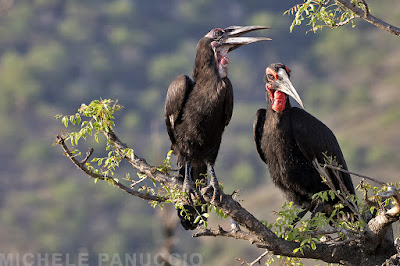Opening the window as any other morning in my life I saw the sun shyne peeping in the mist of the great plain. But even more surprisingly a family of Roe deers was moving just in front of my window. A nice start for this day.
Into The Wild
Wildlife, photography and falling leaves
Tuesday, January 29, 2019
Friday, December 28, 2018
Thursday, December 20, 2018
Kruger National Park - 1 (mammals)
In the end I went to south Saharan Africa. It is probably a crucial moment in a naturalist's life to visit that continent. Several zoologists, including me, started to study wildlife because of the documentaries transmitted on tv. And going on reading books of expeditions and research in Africa. The chance for me to go there was the last Conference of the Raptor Research Foundation in the Kruger National Park, South Africa. I was prepared that is a touristic place but still amazing. So what are my impressions?
The park is beautiful, lot of animals, almost all the African species that you would like to see on your first trip. However hanging round in South Africa I had the feeling that wild Africa doesn't exist anymore. Fences, farms, a widespread urban fabric shape the territory and the wildlife is relegated in a closed area full of tourists who know almost nothing about biodiversity. Moreover black people are relegated to the hardest jobs while white people still retain the upper positions. However the Kruger area is large, animals are beatiful and watching a bateleur hunting over the bush is a priceless moment as well as a group of ienas walking down from a rocky hill at sunrise.
Saturday, November 24, 2018
Purple heron
In this ending 2018 I started to study waterbird movements. One of the project is related to the Purple heron and we tagged one individual last summer with a GPS-GSM. This young bird spent months in the area where it was born until a hunter shot it. This happened a few weeks ago and have left me and my colleagues really sad for this criminal act. However we will go on with the project for sure despite this event. Here below a picture of a Purple heron, the tagged juvenile with my colleague Michelangelo Morganti and the radiography.
Sunday, April 29, 2018
Ponds in April
During migratory seasons everything is possible. This means that is it possible to catch the sight of a rare or unusual bird species almost everywhere. And ponds and wetlands are for sure sites where the chances to observe an unexpected bird species greatly increase. Together with common species that are already breeding, migratory birds stop for a moment or for several days making April one of the best birding months of the year. Here below some pictures that I took this month during some easy walks.
Tuesday, March 6, 2018
Wintering raptors in central Italy
As many other winters in the last years I promoted road counts of wintering raptors, this year in central-western Italy. As expected the commonest species were Common buzzards and Kestrels, however several other species were observed. The most unexpected one was the Long-legged buzzard wintering in an inland area of Latium. Taking a first look to the results, the distribution of wintering raptors looks really disomogeneous with very low density across most of the investigated territory and a few patches with high density of raptors and well stuctured communities. These area are located along the coastline whit existing protected areas. Here below a couple of pictures of wintering Common buzzards.
Wednesday, February 28, 2018
Migration around the Caspian Sea
I was in Iran last autumn together with two excellent local researchers to verify if it exists a migratory flyway of raptors between the southern coast of the the Caspian Sea and the Alborz mountain. The results were exciting since we observed the passage of hundreds of Steppe Eagles and other raptors, storks and bee-eaters. Our field survey reveals that the area is a migratory bottle-necks of paramount importance for Palearctic raptors. Everything there was impressive, the high mountains, the steppic area, the Gorgan Bay with tens of thousands waterbirds and, of course, the migration.
Here below a few pictures of eagles.
Subscribe to:
Comments (Atom)





































